当前位置:网站首页>9 原子操作类之18罗汉增强
9 原子操作类之18罗汉增强
2022-07-07 17:29:00 【乘风会落雨】
9 原子操作类之18罗汉增强
目录
官网说明和阿里要求
LongAdder是Striped64的子类
Striped64
Cell
LongAdder为什么这么快
是什么
都是java.util.concurrent.atomic包下的
有红框圈起来的,也有蓝框圈起来的,为什么?
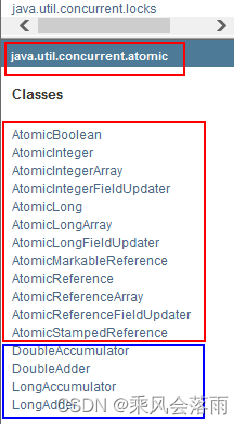
- 阿里巴巴Java开发手册

- 为什么说18罗汉增强,却只有16个

再分类
基本类型原子类
AtomicInteger
AtomicBoolean
AtomicLong
常用API
public final int get()
public final int getAndSet(int new Value)
public final int getAndIncrement()
public final int getAndDecrement()
public final int getAndAdd(int delta)
public comapreAndSet(int expect,int update)//如果
Case-CountDownLatch
- 案例
class MyNumber{
AtomicInteger atomicInteger = new AtomicInteger();
public void addPlusPlus(){
atomicInteger.getAndIncrement();
}
}
public class AtomicIntegerDemo {
public static final int SIZE = 50;
public static void main(String[] args) {
MyNumber myNumber = new MyNumber();
for(int i = 1;i <= SIZE;i ++){
new Thread(() -> {
for(int j = 1;j <= 1000;j ++){
myNumber.addPlusPlus();
}
},String.valueOf(i)).start();
}
System.out.println(Thread.currentThread().getName()+"\t"+"result: "+myNumber.atomicInteger);
}
}
//本来应该是50000
//1试-main result: 39000
//2试-main result: 40178
//?是不是我们的程序有问题?
//因为上面的50* 1000个计算还没结束,他就去get数值了
```*
解决
```java
//方法一(不推荐,做做Demo还行)
public class AtomicIntegerDemo {
public static final int SIZE = 50;
public static void main(String[] args) {
MyNumber myNumber = new MyNumber();
for(int i = 1;i <= SIZE;i ++){
new Thread(() -> {
for(int j = 1;j <= 1000;j ++){
myNumber.addPlusPlus();
}
},String.valueOf(i)).start();
}
try {
TimeUnit.SECONDS.sleep(2);
} catch (InterruptedException e) {
e.printStackTrace();
}
System.out.println(Thread.currentThread().getName()+"\t"+"result: "+myNumber.atomicInteger);
}
}
//方法二-减法计数器CountDownLatch
public class AtomicIntegerDemo {
public static final int SIZE = 50;
public static void main(String[] args) throws InterruptedException {
MyNumber myNumber = new MyNumber();
CountDownLatch countDownLatch = new CountDownLatch(SIZE);
for(int i = 1;i <= SIZE;i ++){
new Thread(() -> {
try {
for(int j = 1;j <= 1000;j ++){
myNumber.addPlusPlus();
}
} finally {
countDownLatch.countDown();
}
},String.valueOf(i)).start();
}
countDownLatch.await();
System.out.println(Thread.currentThread().getName()+"\t"+"result: "+myNumber.atomicInteger);
}
}
//main result: 50000
数组类型原子类
基本原理同上,不做过多演示
AtomicIntegerArray
AtomicLongArray
AtomicRreferenceArray
Case
public class AtomicIntegerArrayDemo
{
public static void main(String[] args)
{
AtomicIntegerArray atomicIntegerArray = new AtomicIntegerArray(new int[5]);//0 0 0 0 0
//AtomicIntegerArray atomicIntegerArray = new AtomicIntegerArray(5);
//AtomicIntegerArray atomicIntegerArray = new AtomicIntegerArray(new int[]{1,2,3,4,5});//1 2 3 4 5
for (int i = 0; i <atomicIntegerArray.length(); i++) {
System.out.println(atomicIntegerArray.get(i));
}
System.out.println();
System.out.println();
System.out.println();
int tmpInt = 0;
tmpInt = atomicIntegerArray.getAndSet(0,1122);
System.out.println(tmpInt+"\t"+atomicIntegerArray.get(0));
atomicIntegerArray.getAndIncrement(1);
atomicIntegerArray.getAndIncrement(1);
tmpInt = atomicIntegerArray.getAndIncrement(1);
System.out.println(tmpInt+"\t"+atomicIntegerArray.get(1));
}
}
引用类型原子类
这三个相对比较重要
AtomicReference
AtomicStampedReference
AtomicMarkableReference
```*
`AtomicReference` 可以带泛型(前面讲过)
`AtomicReference<xxx> `*
`AtomicStampedReference` 带版本号以防CAS中的ABA问题(前面讲过)
携带版本号的引用类型原子类,可以解决ABA问题。解决修改过几次的问题。*
`AtomicMarkableReference`类似于上面的 ,但解决**一次性**问题
构造方法`AtomicMarkableReference(V initialRef, boolean initialMark)`
原子更新带有标记位的引用类型对象
解决是否修改过,它的定义就是将`状态戳`**简化**为`true|false`,类似一次性筷子
```java
//来个案例
public class AtomicMarkableReferenceDemo {
static AtomicMarkableReference markableReference = new AtomicMarkableReference(100,false);
public static void main(String[] args) {
new Thread(()->{
boolean marked = markableReference.isMarked();
System.out.println(Thread.currentThread().getName()+"\t"+"默认标识"+marked);
//暂停1秒钟线程,等待后面的T2线程和我拿到一样的模式flag标识,都是false
try {
TimeUnit.SECONDS.sleep(1);} catch (InterruptedException e) {
e.printStackTrace();}
markableReference.compareAndSet(100, 1000, marked, !marked);
},"t1").start();
new Thread(()->{
boolean marked = markableReference.isMarked();
System.out.println(Thread.currentThread().getName()+"\t"+"默认标识"+marked);
//这里停2秒,让t1先修改,然后t2试着修改
try {
TimeUnit.SECONDS.sleep(2);} catch (InterruptedException e) {
e.printStackTrace();}
boolean t2Result = markableReference.compareAndSet(100, 1000, marked, !marked);
System.out.println(Thread.currentThread().getName()+"\t"+"t2线程result--"+t2Result);
System.out.println(Thread.currentThread().getName()+"\t"+markableReference.isMarked());
System.out.println(Thread.currentThread().getName()+"\t"+markableReference.getReference());
},"t2").start();
}
}
对象的属性修改原子类
关键词FieldUpdater
AtomicIntegerFieldUpdater//原子更新对象中int类型字段的值
AtomicLongFieldUpdater//原子更新对象中Long类型字段的值
AtomicReferenceFieldUpdater//原子更新引用类型字段的值
更加细粒度范围内的原子更新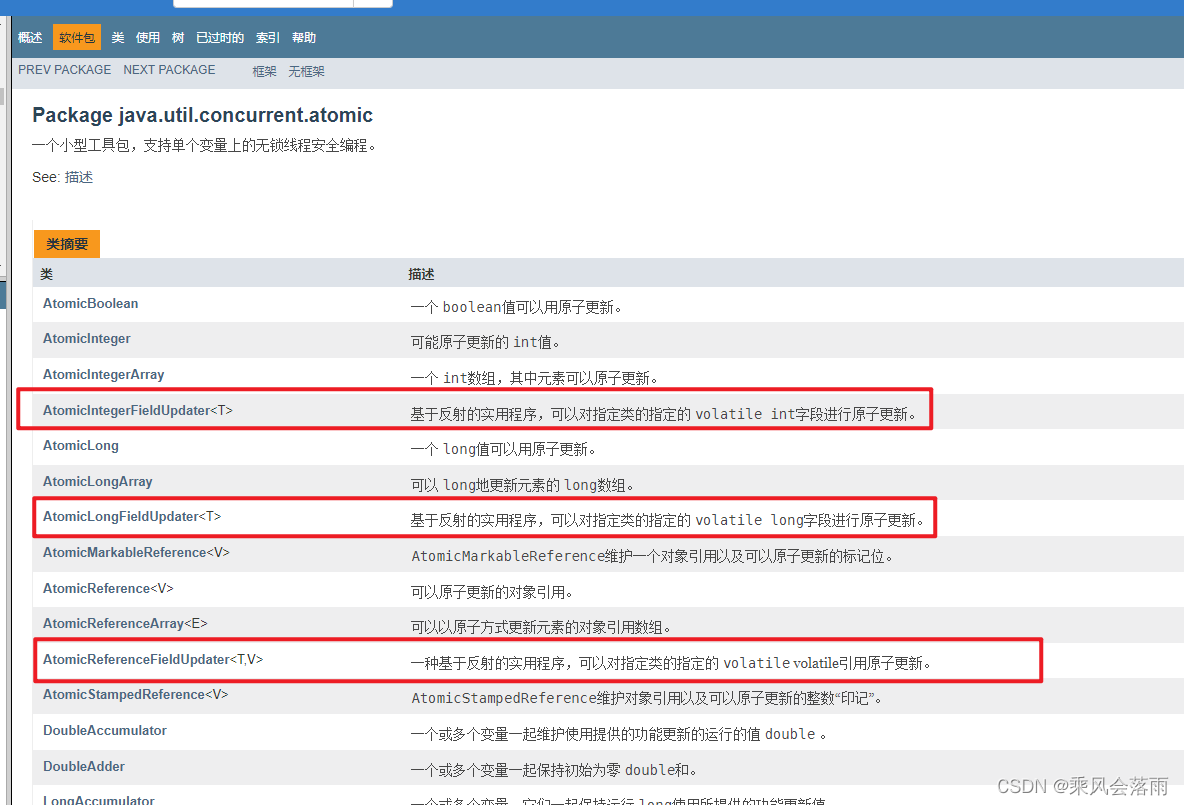
使用目的
- 以一种线程安全带 方式操作非线程安全对象内的某些字段*
举个例子(它是更加细粒度的/影像某个字段,而不用锁住整个对象)

使用要求
- 更新的对象属性必须使用public volatile修饰符*
因为对象的属性修改类型原子类都是抽象类* *,所以每次使用都必须使用静态方法newUpdater()创建一个更新器* *,并且需要设置想要更新的类和属性。
Case
AtomicIntegerFieldUpdater-这个针对int类型
class BankAccount{
String bankName = "CCB";
public volatile int money = 0;//条件一
//synchronized版本
// public synchronized void add(){
// money++;
// }
//AtomicIntegerFieldUpdater版本
AtomicIntegerFieldUpdater<BankAccount> fieldUpdater =
AtomicIntegerFieldUpdater.newUpdater(BankAccount.class,"money");//只限制了money这个字段,条件二
public void transMoney(BankAccount bankAccount){
fieldUpdater.getAndIncrement(bankAccount);
}
}
public class AtomicIntegerFieldUpdaterDemo {
public static void main(String[] args) throws InterruptedException {
BankAccount bankAccount = new BankAccount();
CountDownLatch countDownLatch = new CountDownLatch(10);
for(int i = 1;i <= 10;i ++){
new Thread(()->{
try {
for(int j = 1;j <= 1000;j ++){
// bankAccount.add();
bankAccount.transMoney(bankAccount);
}
} finally {
countDownLatch.countDown();
}
},String.valueOf(i)).start();
}
countDownLatch.await();
System.out.println(Thread.currentThread().getName()+"\t"+"result: "+bankAccount.money);
}
}
//main result: 10000
```*
`AtomicReferenceFieldUpdater`-适用度更广
```java
//比如这个案例中是针对boolean类型的
class MyVar{
public volatile Boolean isInit = Boolean.FALSE;
AtomicReferenceFieldUpdater<MyVar,Boolean> referenceFieldUpdater =
AtomicReferenceFieldUpdater.newUpdater(MyVar.class,Boolean.class,"isInit");
public void init(MyVar myVar){
if(referenceFieldUpdater.compareAndSet(myVar,Boolean.FALSE,Boolean.TRUE)){
System.out.println(Thread.currentThread().getName()+"\t"+"-----start init,needs 3 seconds");
try {
TimeUnit.SECONDS.sleep(3);} catch (InterruptedException e) {
e.printStackTrace();}
System.out.println(Thread.currentThread().getName()+"\t"+"-----over init");
}else{
System.out.println(Thread.currentThread().getName()+"\t"+"抱歉,已经有其他线程进行了初始化");
}
}
}
public class AtomicReferenceFieldUpdaterDemo {
public static void main(String[] args) {
MyVar myVar = new MyVar();
for(int i = 1;i <= 5;i ++){
new Thread(()->{
myVar.init(myVar);
},String.valueOf(i)).start();
}
}
}
//1 -----start init,needs 3 seconds
//5 抱歉,已经有其他线程进行了初始化
//4 抱歉,已经有其他线程进行了初始化
//2 抱歉,已经有其他线程进行了初始化
//3 抱歉,已经有其他线程进行了初始化
//1 -----over init
面试
面试官问你:你在哪里用了volatile?
在AtomicReferenceFieldUpdater中,因为是规定好的必须由volatile修饰的
还有的话之前我们在DCL单例中,也用了volatile保证了可见性
原子操作增强类原理深度解析
开篇的时候我们将原子类分为了红框和蓝框,这里就是蓝框的内容
//这几个都是java8开始有的,前面的都是java5就有了
DoubleAccumulator
DoubleAdder
LongAccumulator
LongAdder
阿里要命题目

热点商品点赞计算器,点赞数加加统计,不要求实时精确
一个很大的List,里面都是int类型,如何实现加加,说说思路
模拟下点赞计数器,看看性能
- 要求:热点商品点赞计算器,点赞数加加统计,不要求实时精确
看看这个LongAdder
- 看看这个LongAccumulator
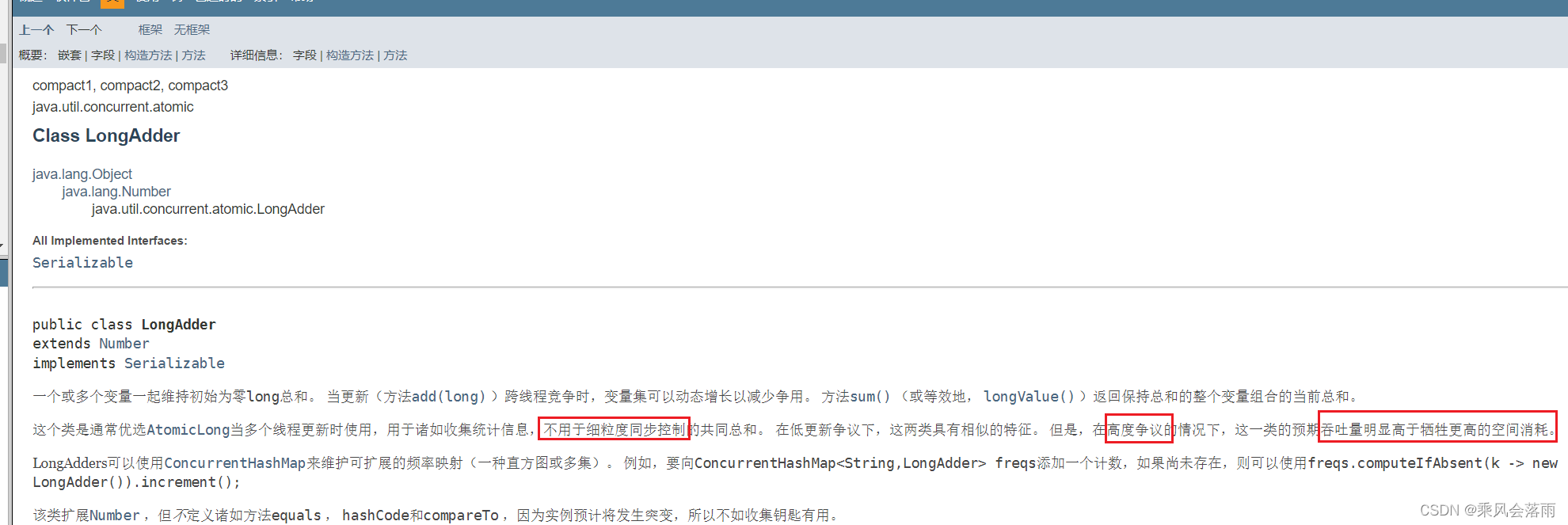
常用API

入门讲解
LongAdder只能用来计算加法 。且从零开始计算
LongAccumulator提供了自定义的函数操作 (利用lambda表达式)
public class LongAdderAPIDemo {
public static void main(String[] args) {
LongAdder longAdder = new LongAdder();
longAdder.increment();
longAdder.increment();
longAdder.increment();
System.out.println(longAdder.longValue());//3
LongAccumulator longAccumulator = new LongAccumulator((x, y) -> x + y, 0);//lambda表达式
longAccumulator.accumulate(1);//1
longAccumulator.accumulate(3);//4
System.out.println(longAccumulator.get());//4
}
}
LongAdder高性能对比Code演示
//需求:50个线程,每个线程100w次,计算总点赞数
class ClickNumber{
int number = 0;
public synchronized void add1(){
number++;
}
AtomicLong atomicLong = new AtomicLong(0);
public void add2(){
atomicLong.incrementAndGet();
}
LongAdder longAdder =new LongAdder();
public void add3(){
longAdder.increment();
}
LongAccumulator longAccumulator = new LongAccumulator((x,y) -> x + y,0);
public void add4(){
longAccumulator.accumulate(1);
}
}
public class AccumulatorCompareDemo {
public static final int _1W = 1000000;
public static final int threadNumber = 50;
public static void main(String[] args) throws InterruptedException {
ClickNumber clickNumber = new ClickNumber();
Long startTime;
Long endTime;
CountDownLatch countDownLatch1 = new CountDownLatch(50);
CountDownLatch countDownLatch2 = new CountDownLatch(50);
CountDownLatch countDownLatch3 = new CountDownLatch(50);
CountDownLatch countDownLatch4 = new CountDownLatch(50);
startTime = System.currentTimeMillis();
for(int i = 1;i <= threadNumber;i ++){
new Thread(()->{
try {
for(int j = 1;j <=_ 1W;j ++){
clickNumber.add1();
}
} finally {
countDownLatch1.countDown();
}
},String.valueOf(i)).start();
}
countDownLatch1.await();
endTime = System.currentTimeMillis();
System.out.println("costTime---"+(endTime-startTime)+"毫秒"+"\t"+"synchronized---"+clickNumber.number);
startTime = System.currentTimeMillis();
for(int i = 1;i <= threadNumber;i ++){
new Thread(()->{
try {
for(int j = 1;j <=_ 1W;j ++){
clickNumber.add2();
}
} finally {
countDownLatch2.countDown();
}
},String.valueOf(i)).start();
}
countDownLatch2.await();
endTime = System.currentTimeMillis();
System.out.println("costTime---"+(endTime-startTime)+"毫秒"+"\t"+"atomicLong---"+clickNumber.atomicLong);
startTime = System.currentTimeMillis();
for(int i = 1;i <= threadNumber;i ++){
new Thread(()->{
try {
for(int j = 1;j <=_ 1W;j ++){
clickNumber.add3();
}
} finally {
countDownLatch3.countDown();
}
},String.valueOf(i)).start();
}
countDownLatch3.await();
endTime = System.currentTimeMillis();
System.out.println("costTime---"+(endTime-startTime)+"毫秒"+"\t"+"LongAdder---"+clickNumber.longAdder.sum());
startTime = System.currentTimeMillis();
for(int i = 1;i <= threadNumber;i ++){
new Thread(()->{
try {
for(int j = 1;j <=_ 1W;j ++){
clickNumber.add4();
}
} finally {
countDownLatch4.countDown();
}
},String.valueOf(i)).start();
}
countDownLatch4.await();
endTime = System.currentTimeMillis();
System.out.println("costTime---"+(endTime-startTime)+"毫秒"+"\t"+"LongAccumulator---"+clickNumber.longAccumulator.longValue());
}
//costTime---2205毫秒 synchronized---50000000
//costTime---435毫秒 atomicLong---50000000
//costTime---86毫秒 LongAdder---50000000
//costTime---84毫秒 LongAccumulator---50000000
}//印证了阿里卡法手册中说的 【如果是JDK8,推荐使用LongAdder对象,比AtomicLong性能更好(减少乐观锁的重试次数)】
源码、原理分析
架构
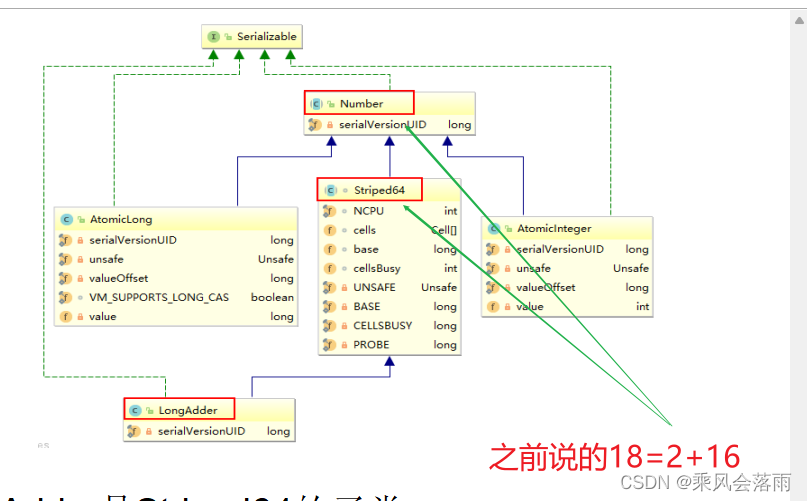
LongAdder是Striped64的子类
public class LongAdder extends Striped64 implements Serializable {
private static final long serialVersionUID = 7249069246863182397L;
//---------------------------
abstract class Striped64 extends Number {
原理(LongAdder为什么这么快)
官网说明和阿里要求
阿里说明

- 官网说明
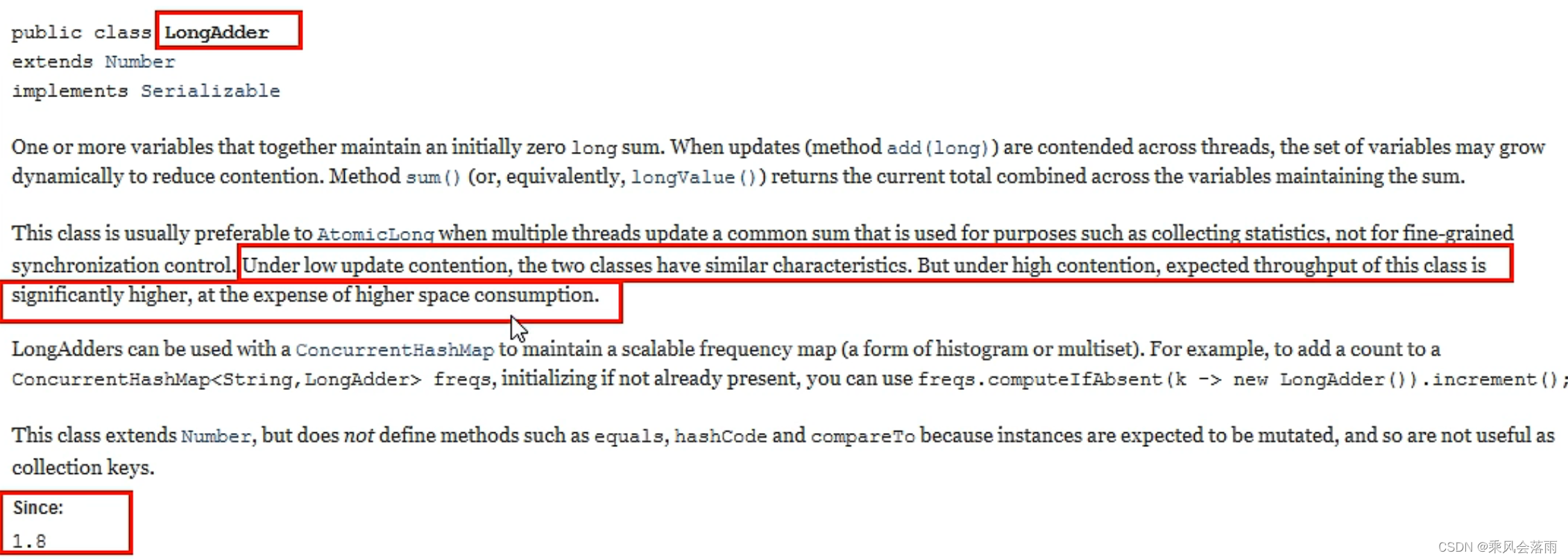
LongAdder是Striped64的子类
Striped64
- 重要的成员函数
//Number of CPUS, to place bound on table size
// CPU数量,即cells数组的最大长度
static final int NCPU = Runtime.getRuntime().availableProcessors();
//Table of cells. When non-null, size is a power of 2.
//单元格数组|cells数组,为2的幂,2,4,8,16.....,方便以后位运算
transient volatile Cell[] cells;
//基础value值,当并发较低时,只累加该值主要用于没有竞争的情况,通过CAS更新。
//Base value, used mainly when there is no contention, but also as
//a fallback during table initialization races. Updated via CAS.
transient volatile long base;
//创建或者扩容Cells数组时使用的自旋锁变量调整单元格大小(扩容),创建单元格时使用的锁。
//Spinlock (locked via CAS) used when resizing and/or creating Cells.
transient volatile int cellsBusy;
最重要的两个
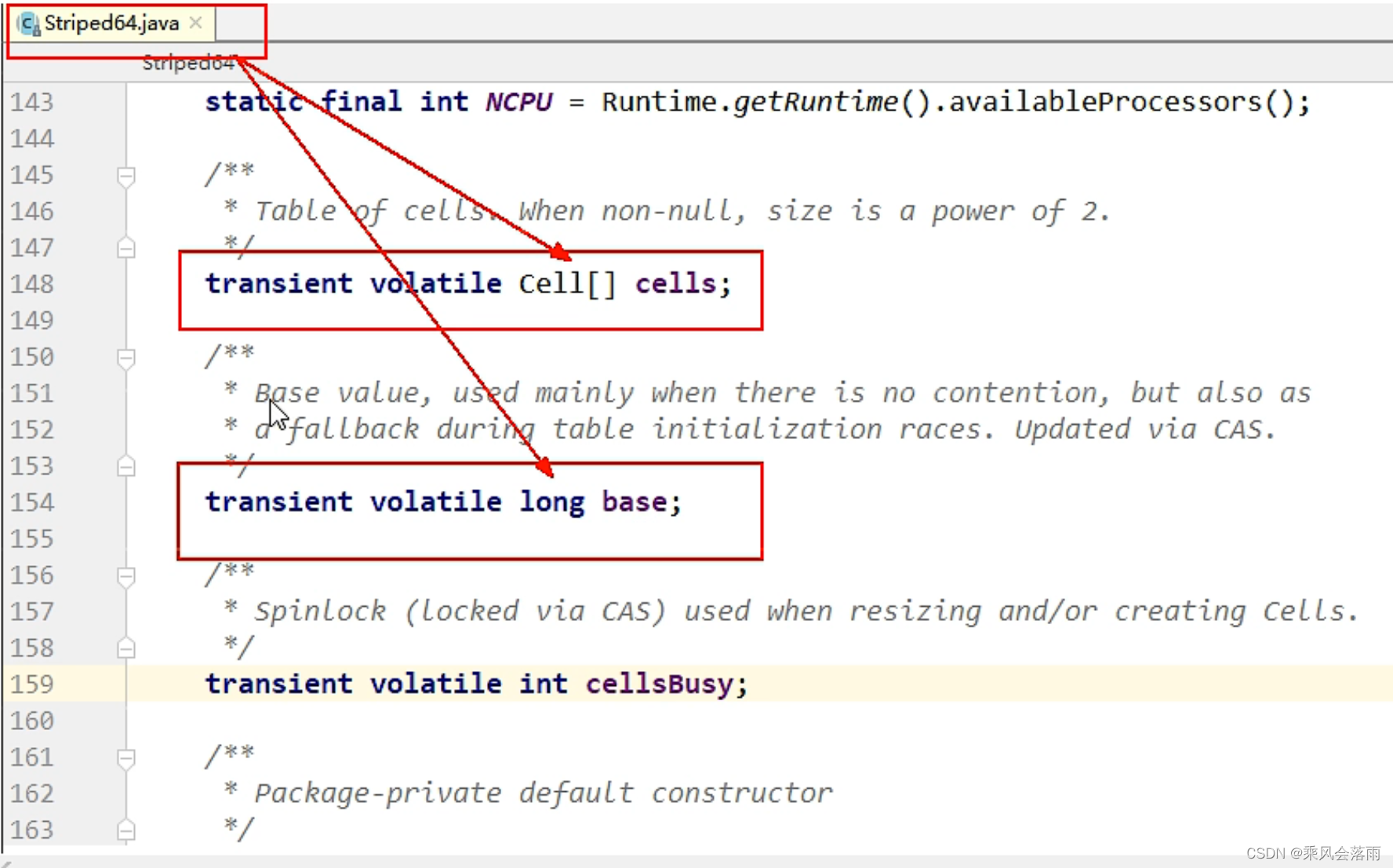
- Striperd64中一些变量或者方法的定义
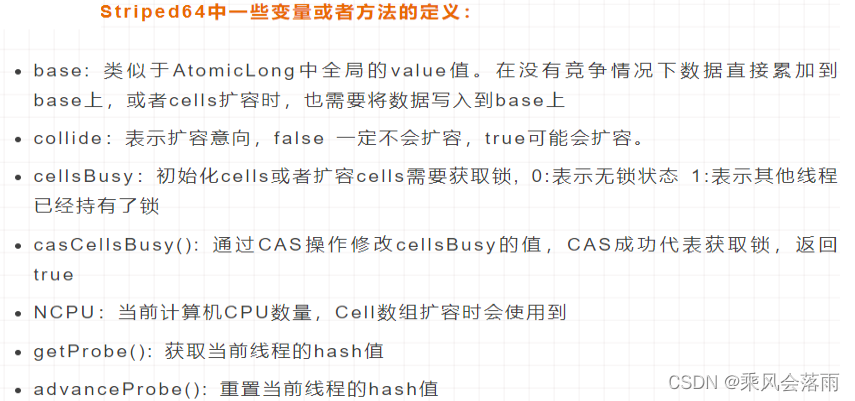
Cell
是java.util.concurrent.atomic下Striped64的一个静态内部类
@sun.misc.Contended static final class Cell {
volatile long value;
Cell(long x) {
value = x; }
final boolean cas(long cmp, long val) {
return UNSAFE.compareAndSwapLong(this, valueOffset, cmp, val);
}
// Unsafe mechanics
private static final sun.misc.Unsafe UNSAFE;
private static final long valueOffset;
static {
try {
UNSAFE = sun.misc.Unsafe.getUnsafe();
Class<?> ak = Cell.class;
valueOffset = UNSAFE.objectFieldOffset
(ak.getDeclaredField("value"));
} catch (Exception e) {
throw new Error(e);
}
}
}
LongAdder为什么这么快
其实在小并发下情况差不多;但在高并发情况下,在AtomicLong中,等待的线程会不停的自旋,导致效率比较低;而LongAdder用cell[]分了几个块出来,最后统计总的结果值(base+所有的cell值),分散热点。
举个形象的例子,火车站买火车票,AtomicLong 只要一个窗口,其他人都在排队;而LongAdder 利用cell开了多个卖票窗口,所以效率高了很多。
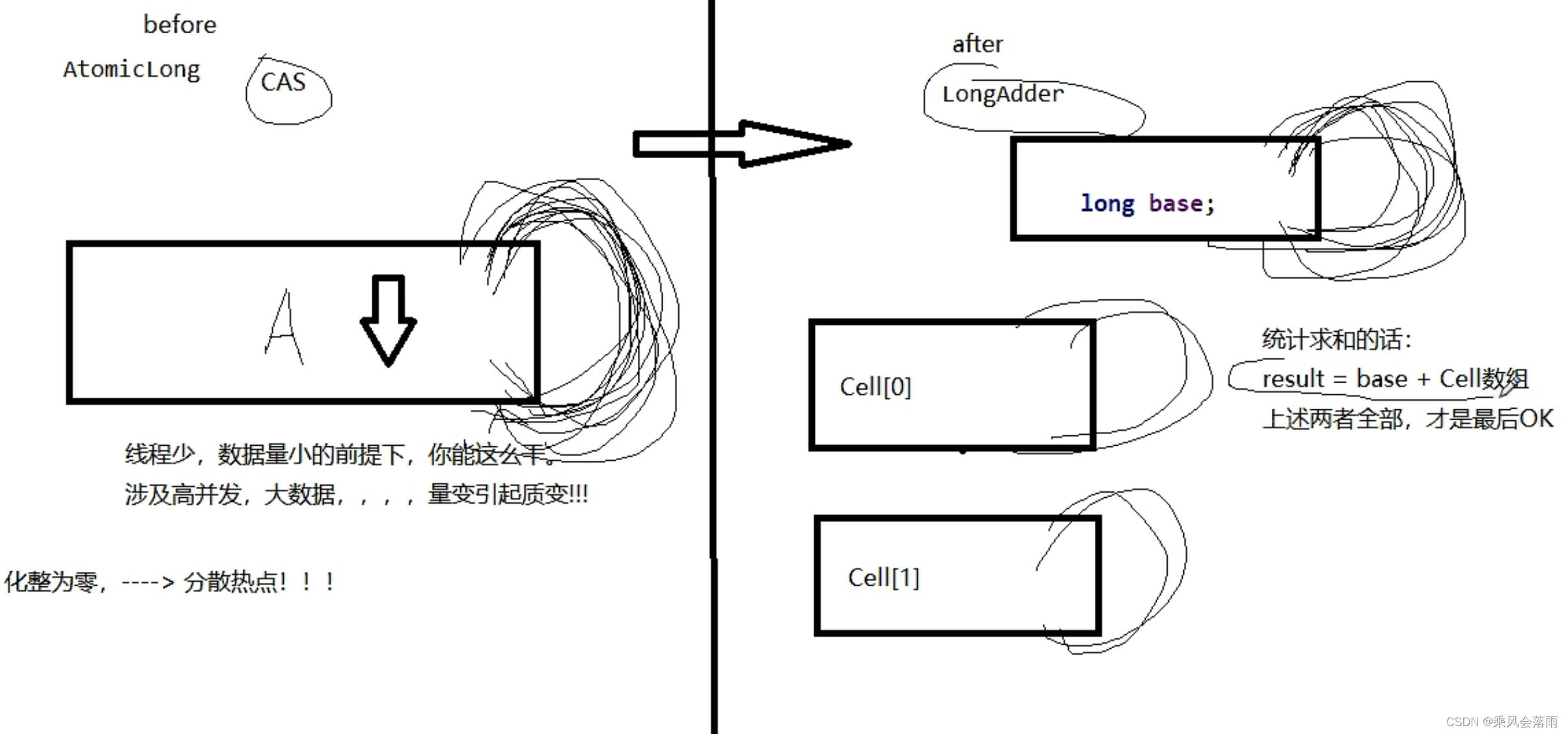
一句话
LongAdder的基本思路就是分散热点 ,将value值分散到一个Cell数组中,不同线程会命中到数组的不同槽中,各个线程只对自己槽中的那个值进行CAS操作,这样热点就被分散了,冲突的概率就小很多。如果要获取真正的long值,只要将各个槽中的变量值累加返回。
sum()会将所有Cell数组中的value和base累加作为返回值,核心的思想就是将之前AtomicLong一个value的更新压力分散到多个value中去,从而降级更新热点 。
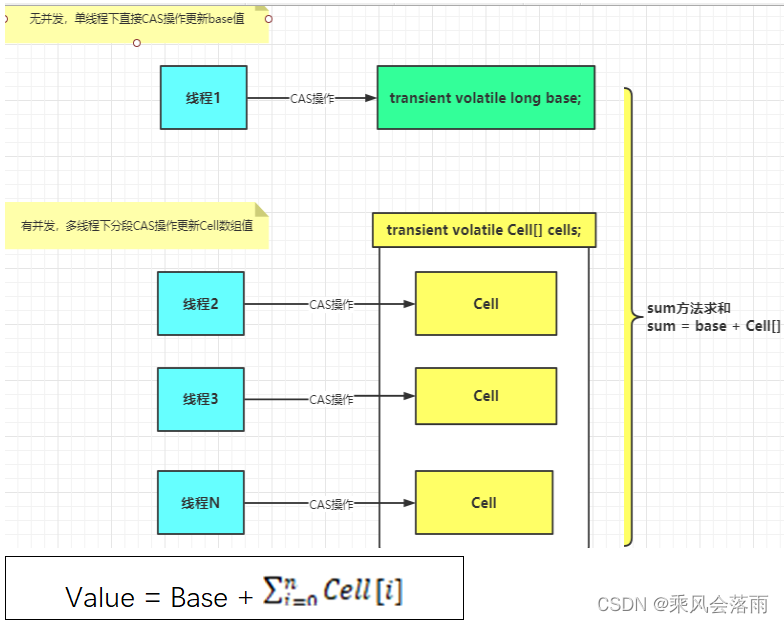
- 数学表达
内部有一个base变量,一个Cell[]数组。
base变量:非竞态条件下,直接累加到该变量上
Cell[]数组:竞态条件下,累加各个线程自己的槽Cell[i]中
源码解读深度分析
小总结
LongAdder在无竞争的情况,跟AtomicLong一样,对同一个base进行操作,当出现竞争关系时则是采用化整为零的做法,从空间换时间,用一个数组 \ \ ,将一个value拆分进这个数组cells。多个线程需要同时对value进行操作时候,可以对线程id进行hash得到hash值,再根据hash值映射到这个数组cells的某个下标,再对该下标所对应的值进行自增操作。当所有线程操作完毕,将数组cells的所有值和无竞争值base都加起来作为最终结果。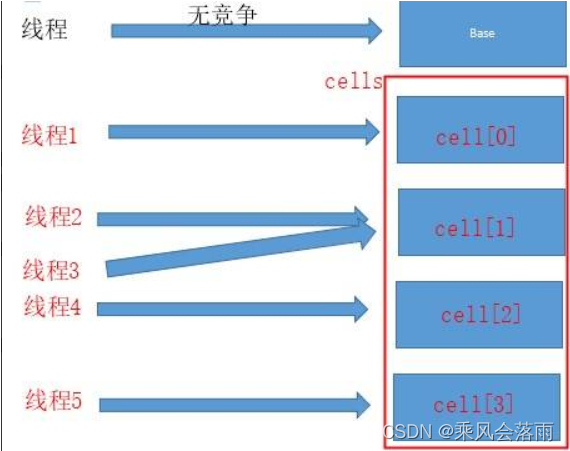
LongAdder.increment()
必须二刷
- 1-add(1L)
public class LongAdder extends Striped64 implements Serializable {
private static final long serialVersionUID = 7249069246863182397L;
/*** Creates a new adder with initial sum of zero.* / public LongAdder() { } /*** Adds the given value.** @param x the value to add* / public void add(long x) { Cell[] as; long b, v; int m; Cell a; if ((as = cells) != null || !casBase(b = base, b + x)) { boolean uncontended = true; if (as == null || (m = as.length - 1) < 0 || (a = as[getProbe() & m]) == null || !(uncontended = a.cas(v = a.value, v + x))) longAccumulate(x, null, uncontended); } } //真正干活的是longAccumulate //as表示cells引用 //b表示获取的base值 //v表示期望值 //m表示cells数组的长度 //a表示当前线程命中的cell单元格 uncontended代表没有冲突。
我们点进这个casBase发现他也是个CAS
final boolean casBase(long cmp, long val) {
return UNSAFE.compareAndSwapLong(this, BASE, cmp, val);
}
一开始竞争小的时候CAS能成功,也就是casBase能成功,然后cells也是空的,所以不会进到循环
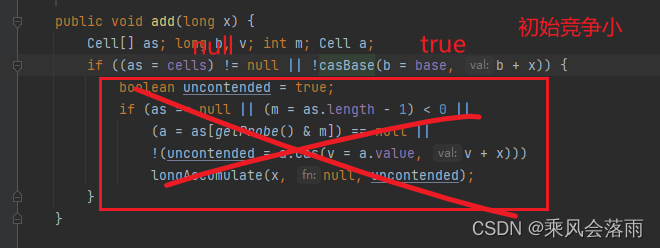
竞争大的时候,他会Cell[] rs = new Cell[2]; 新建两个cell, 此时≠ null ,条件满足了,进入循环。
然后这里还有一层循环,这里是多个if并排
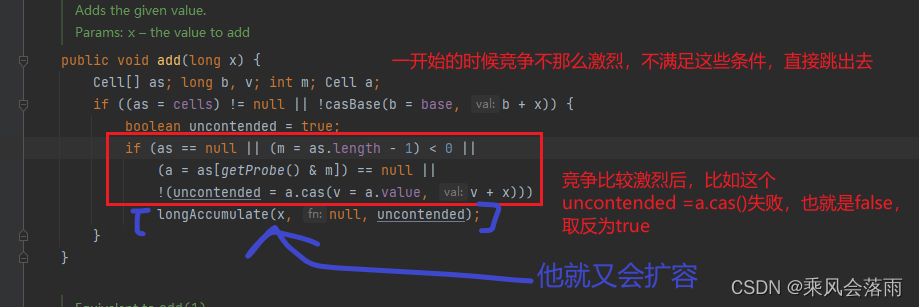
总结一下
1.最初无竞争时只更新base;
2.如果更新base失败后,首次新建一个Cell[]数组
3.当多个线程竞争同一个Cell比价激烈时,可能就要利用longAccumulate对Cell[]扩容。
再次小总结
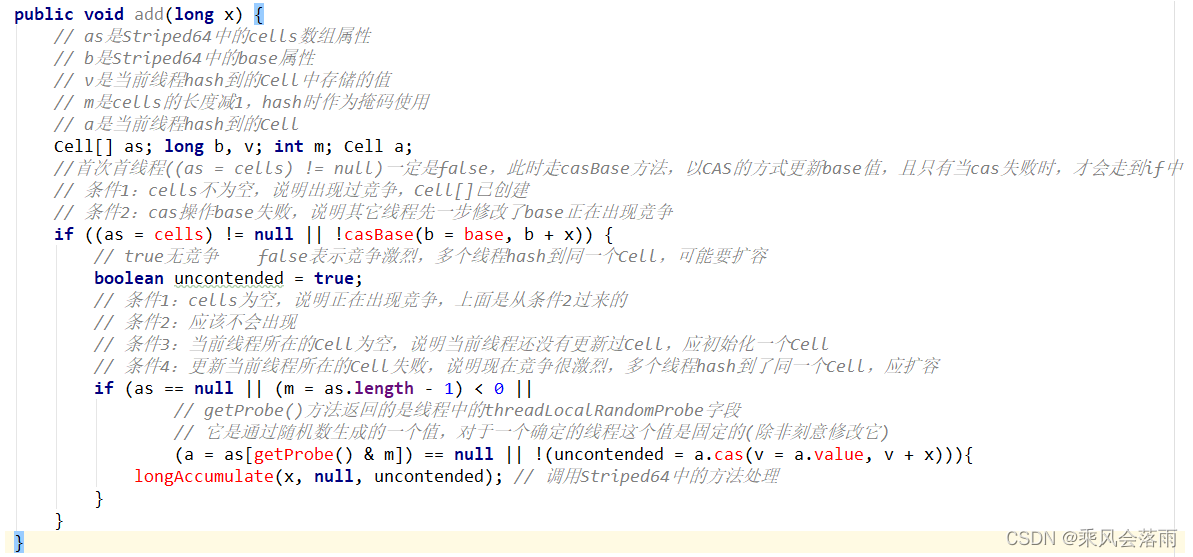
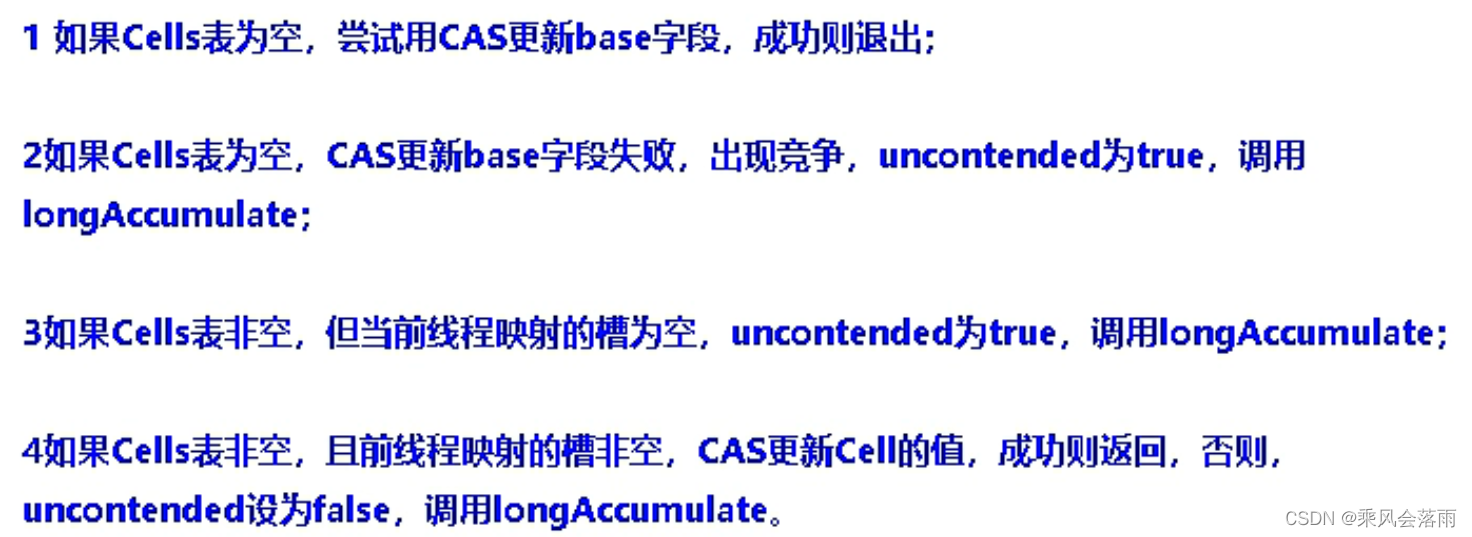
2-longAccumulate
final void longAccumulate(long x, LongBinaryOperator fn,
boolean wasUncontended) {
int h;
if ((h = getProbe()) == 0) {
ThreadLocalRandom.current(); // force initialization
h = getProbe();
wasUncontended = true;
}
boolean collide = false; // True if last slot nonempty
for (;;) {
Cell[] as; Cell a; int n; long v;
if ((as = cells) != null && (n = as.length) > 0) {
//这里是③ Cell数组不再为空且可能存在Cell数组扩容
if ((a = as[(n - 1) & h]) == null) {
if (cellsBusy == 0) {
// Try to attach new Cell
Cell r = new Cell(x); // Optimistically create
if (cellsBusy == 0 && casCellsBusy()) {
boolean created = false;
try {
// Recheck under lock
Cell[] rs; int m, j;
if ((rs = cells) != null &&
(m = rs.length) > 0 &&
rs[j = (m - 1) & h] == null) {
rs[j] = r;
created = true;
}
} finally {
cellsBusy = 0;
}
if (created)
break;
continue; // Slot is now non-empty
}
}
collide = false;
}
else if (!wasUncontended) // CAS already known to fail
wasUncontended = true; // Continue after rehash
else if (a.cas(v = a.value, ((fn == null) ? v + x :
fn.applyAsLong(v, x))))
break;
else if (n >= NCPU || cells != as)//不能超过cpu核数
collide = false; // At max size or stale
else if (!collide)
collide = true;
else if (cellsBusy == 0 && casCellsBusy()) {
try {
if (cells == as) {
// Expand table unless stale
Cell[] rs = new Cell[n << 1];//扩容-左移一位,相当于x2
for (int i = 0; i < n; ++i)
rs[i] = as[i];
cells = rs;
}
} finally {
cellsBusy = 0;
}
collide = false;
continue; // Retry with expanded table
}
h = advanceProbe(h);
}
else if (cellsBusy == 0 && cells == as && casCellsBusy()) {
//这里是①初始化
boolean init = false;
try {
// Initialize table
if (cells == as) {
Cell[] rs = new Cell[2];
rs[h & 1] = new Cell(x);
cells = rs;
init = true;
//------可以先看这里,进行了初始化,长度是2
//------cells数组,为2的幂,2,4,8,16,方便以后位运算
}
} finally {
cellsBusy = 0;
}
if (init)
break;
}
else if (casBase(v = base, ((fn == null) ? v + x :
fn.applyAsLong(v, x))))//这里是②兜底
break; // Fall back on using base
}
}
- LongAccumulate入参说明

- Striped64中一些变量或者方法的定义
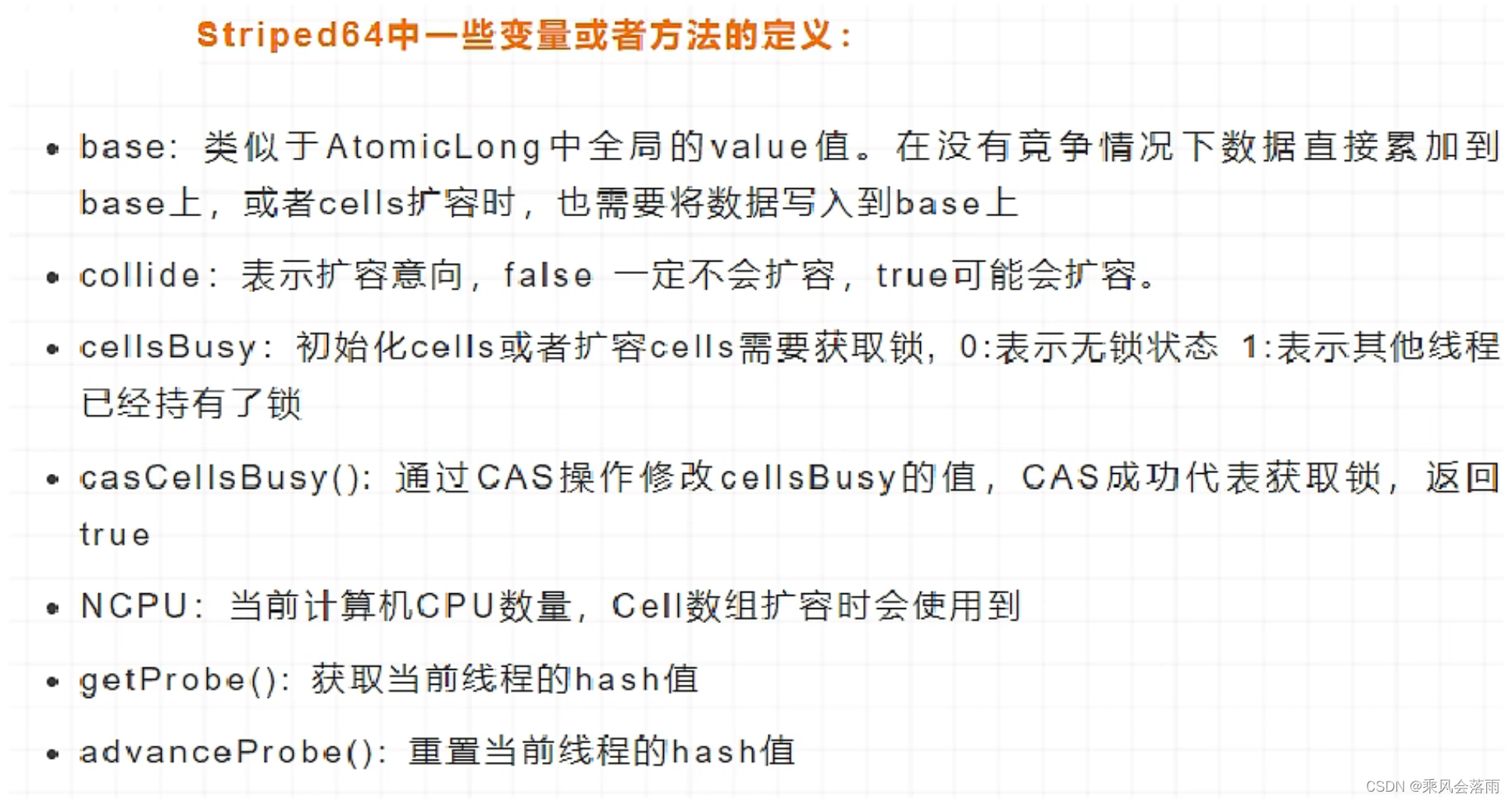
步骤
我们先讲这个
(a = as[getProbe() & m])里的probe,这里其实拿了hash值,通过hash值知道我们去到哪个cell槽
static final int getProbe() {
return UNSAFE.getInt(Thread.currentThread(), PROBE);
}
//其实就是得到了线程的Hash值
所以最前面的这一段就像是新员工入职获取工号(hash值)一样
- 总纲
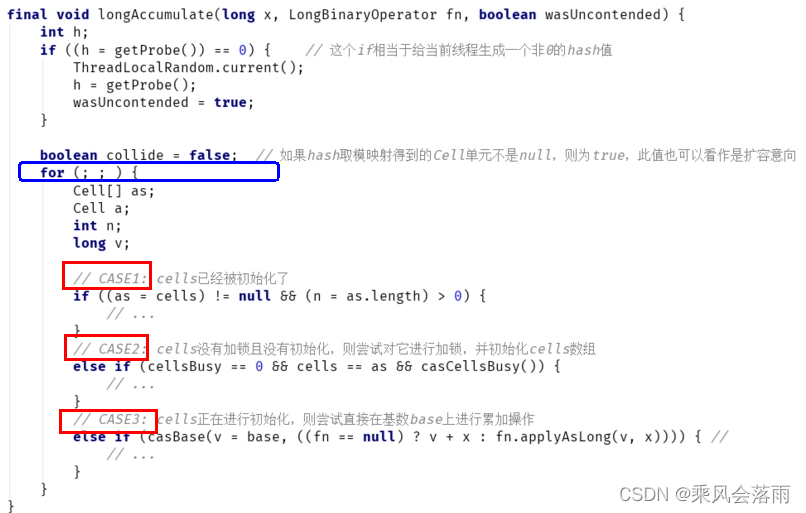
上述代码首先给当前线程分配一个hash值,然后进入一个for(;;)自旋,这个自旋分为三个分支:
CASE1:Cell[]数组已经初始化
CASE2:Cell[]数组未初始化(首次新建)
CASE3:Cell[]数组正在初始化中
- 计算
①刚刚要初始化Cell[]数组(首次新建)
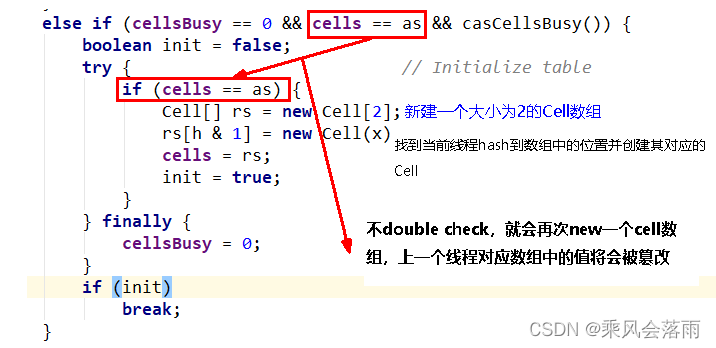
如果上面条件都执行成功就会执行数组的初始化及赋值操作, Cell[] rs = new Cell[2]表示数组的长度为2,
rs[h & 1] = new Cell(x) 表示创建一个新的Cell元素,value是x值,默认为1。
h & 1类似于我们之前HashMap常用到的计算散列桶index的算法,通常都是hash & (table.len - 1)。同hashmap一个意思。
②兜底
多个线程尝试CAS修改失败的线程会走到这个分支
//排在最后面的
else if (casBase(v = base, ((fn == null) ? v + x :
fn.applyAsLong(v, x))))
//该分支实现直接操作base基数,将值累加到base上,也即其它线程正在初始化,多个线程正在更新base的值。
③Cell数组不再为空且可能存在Cell数组扩容
多个线程同时命中一个cell的竞争,这个是最复杂的部分
(1)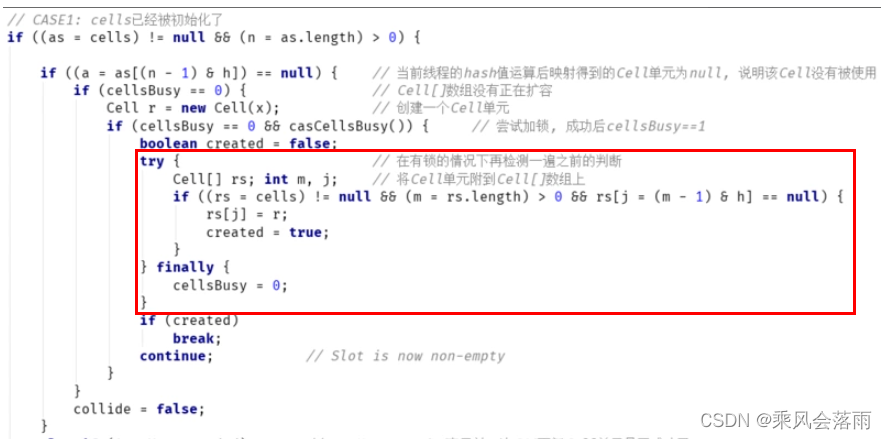
上面代码判断当前线程hash后指向的数据位置元素是否为空,
如果为空则将Cell数据放入数组中,跳出循环。
如果不空则继续循环。
(2)
![[外链图片转存失败,源站可能有防盗链机制,建议将图片保存下来直接上传(img-BDY3L1CW-1656407207550)(image/image_miqNJM3b9d.png)]](/img/29/31dc291e0792625dd19ee967875fef.png)
(3)

说明当前线程对应的数组中有了数据,也重置过hash值,
这时通过CAS操作尝试对当前数中的value值进行累加x操作,x默认为1,如果CAS成功则直接跳出循环。
(4)
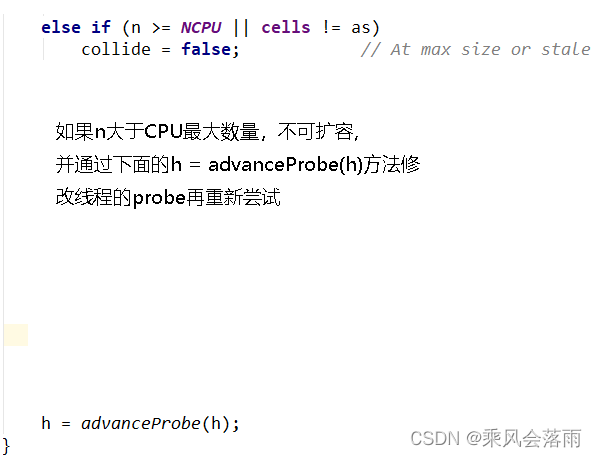
(5)
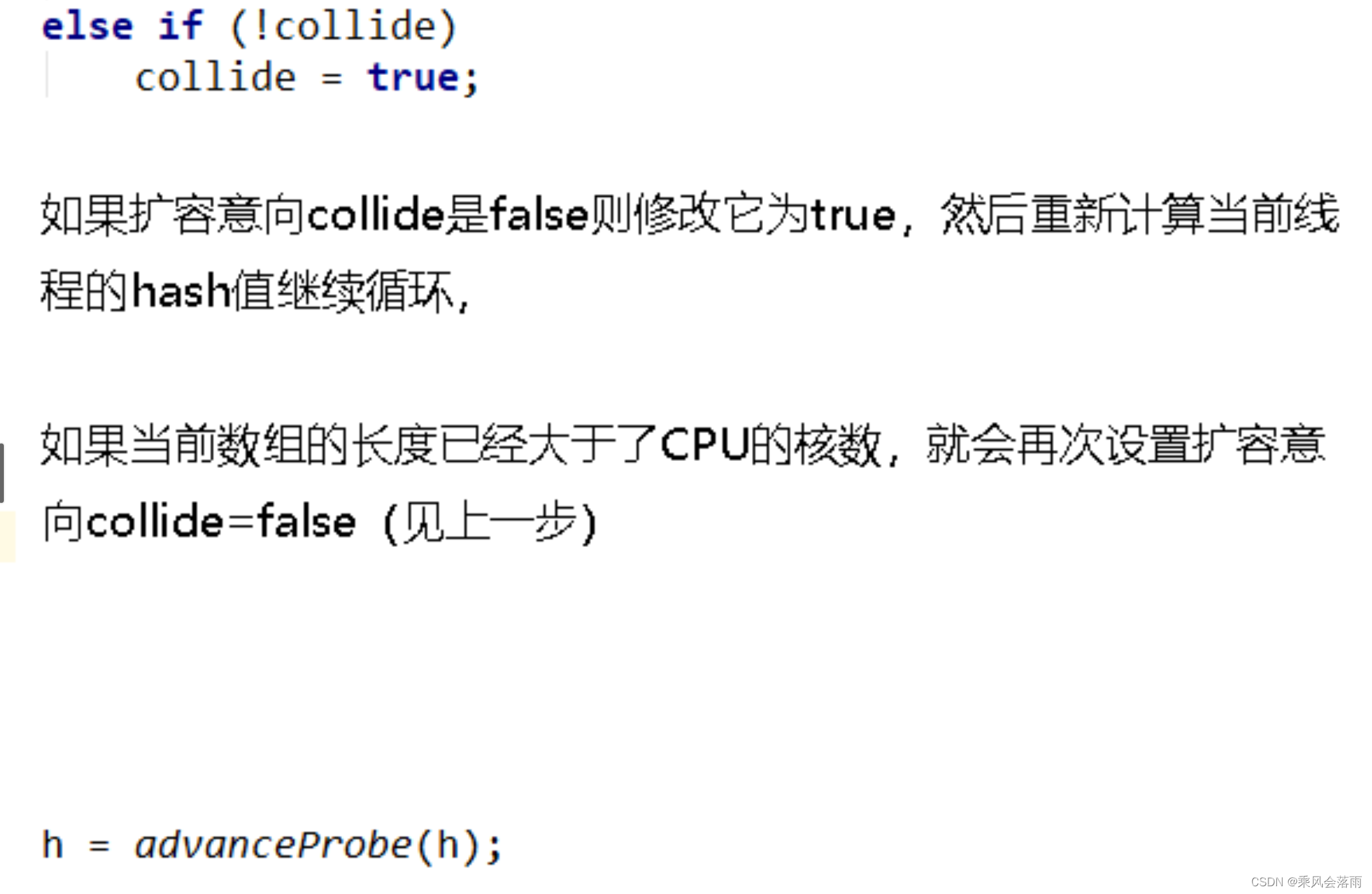
(6)
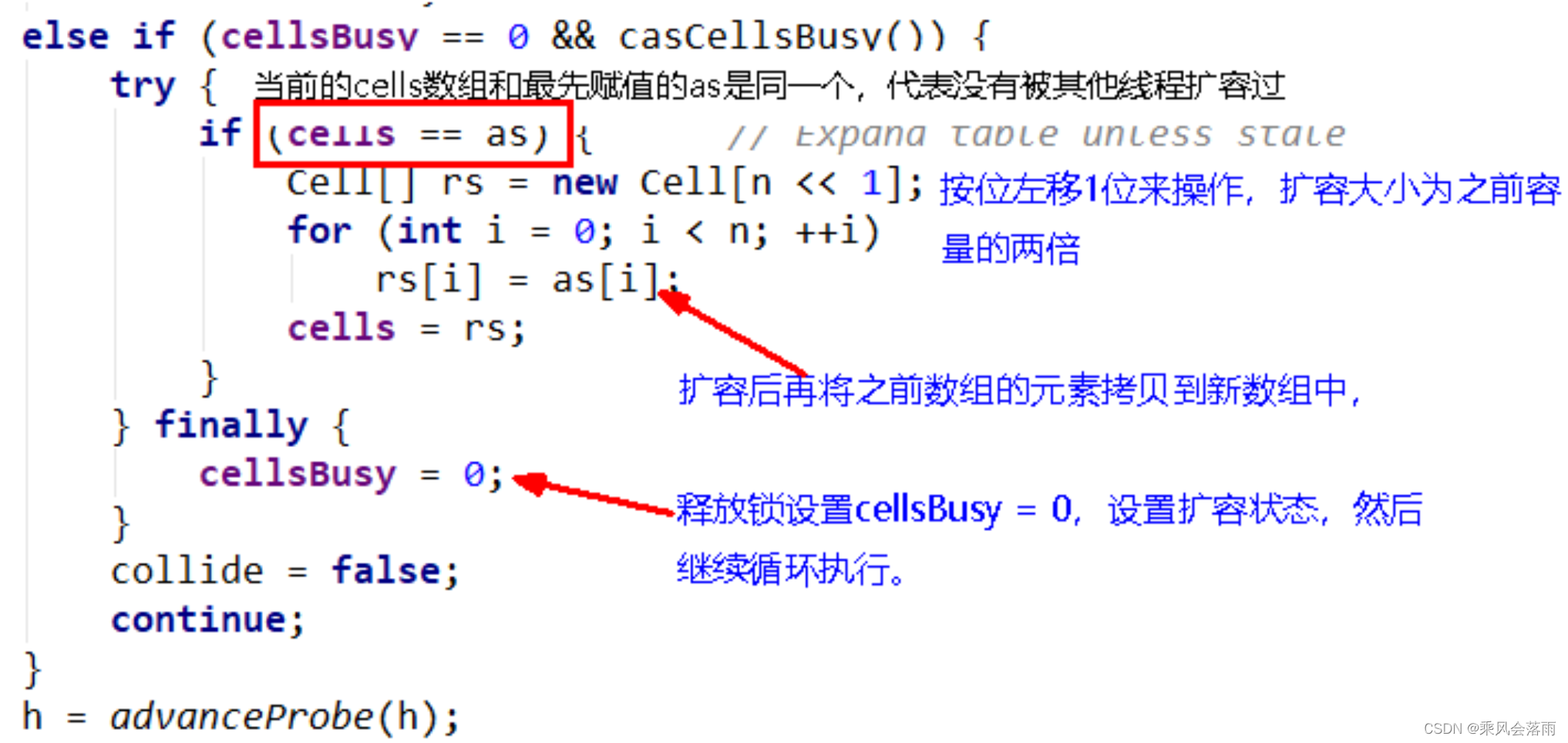
- 以上六步总结
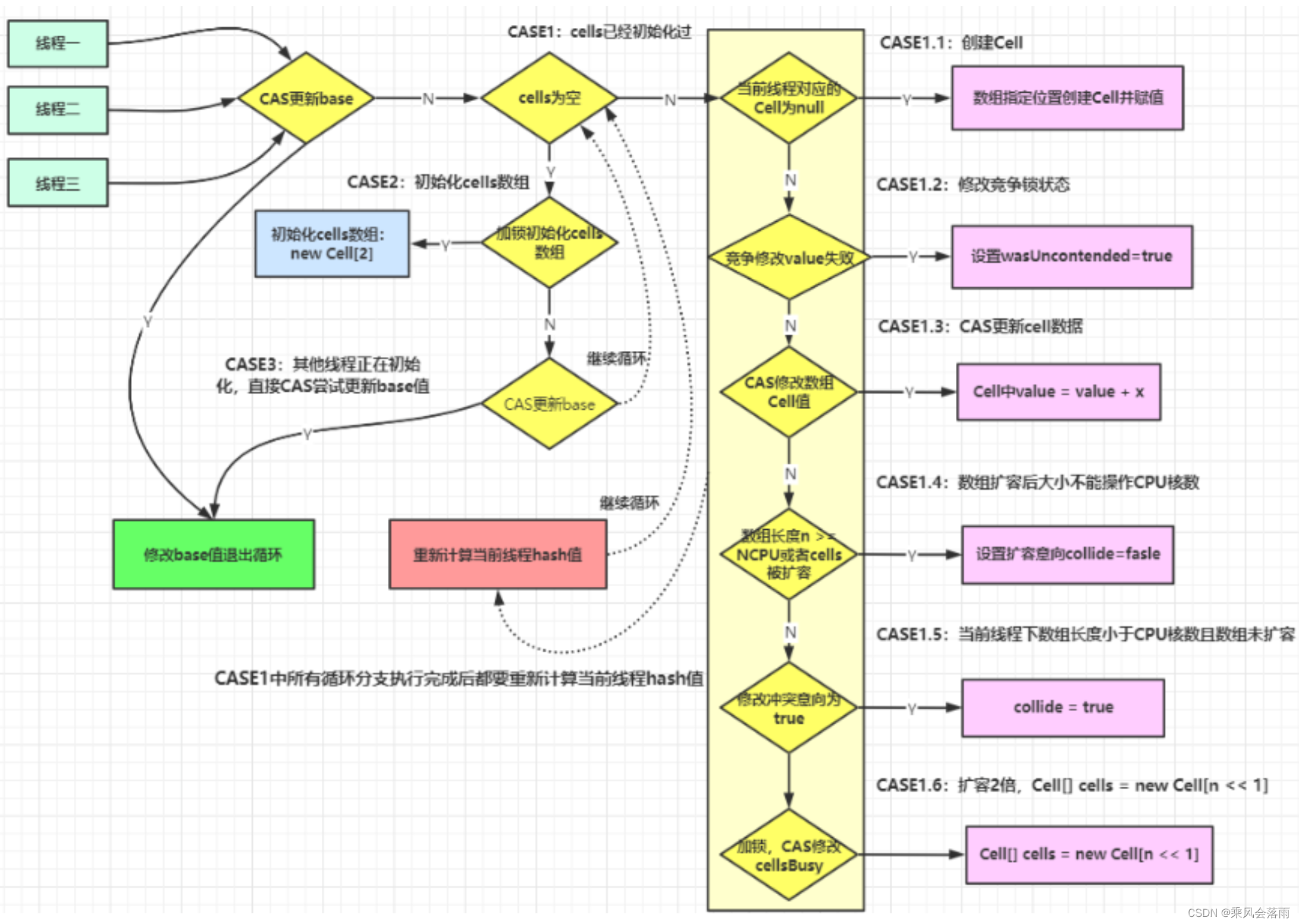
3-sum
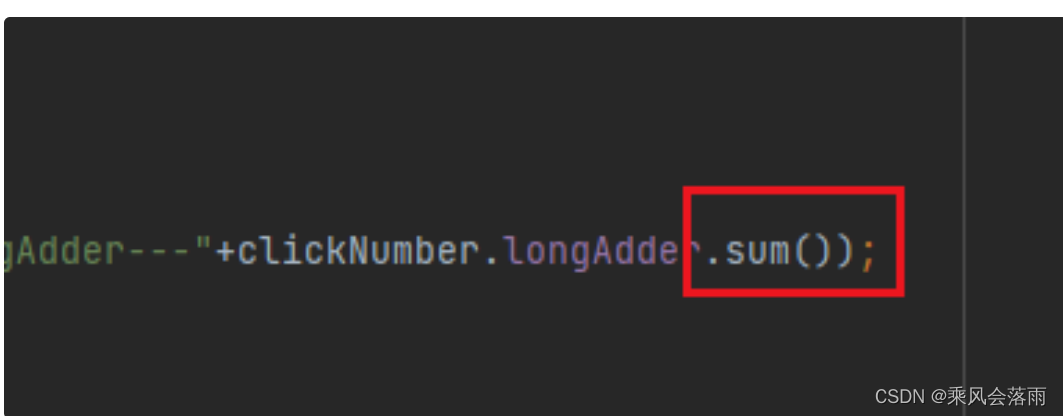
//LongAdder.java
public long sum() {
Cell[] as = cells; Cell a;
long sum = base;
if (as != null) {
for (int i = 0; i < as.length; ++i) {
if ((a = as[i]) != null)
sum += a.value;
}
}
return sum;
}
sum()会将所有Cell数组中的value和base累加作为返回值。
核心的思想就是将之前AtomicLong一个value的更新压力分散到多个value中去,从而降级更新热点 。
为啥在并发情况下sum的值不精确?
sum执行时,并没有限制对base和cells的更新(一句要命的话)。所以LongAdder不是强一致性的,它是最终一致性的。
首先,最终返回的sum局部变量,初始被复制为base,而最终返回时,很可能base已经被更新了 ,而此时局部变量sum不会更新,造成不一致。
其次,这里对cell的读取也无法保证是最后一次写入的值。所以,sum方法在没有并发的情况下,可以获得正确的结果。
使用总结
AtomicLong
线程安全,可允许一些性能损耗,要求高精度时可使用
保证精度,性能代价
AtomicLong是多个线程针对单个热点值value进行原子操作
LongAdder
当需要在高并发下有较好的性能表现,且对值的精确度要求不高时,可以使用
保证性能,精度代价
LongAdder是每个线程拥有自己的槽,各个线程一般只对自己槽中的那个值进行CAS操作
小总结
AtomicLong
原理
CAS+自旋
incrementAndGet
场景
低并发下的全局计算
AtomicLong能保证并发情况下计数的准确性,其内部通过CAS来解决并发安全性的问题
缺陷
高并发后性能急剧下降
why?AtomicLong的自旋会称为瓶颈(N个线程CAS操作修改线程的值,每次只有一个成功过,其它N - 1失败,失败的不停的自旋直到成功,这样大量失败自旋的情况,一下子cpu就打高了。)
LongAdder
原理
CAS+Base+Cell数组分散
空间换时间并分散了热点数据
场景
高并发的全局计算
缺陷
sum求和后还有计算线程修改结果的话,最后结果不够准确
边栏推荐
- 初识缓存以及ehcache初体验「建议收藏」
- 99% of people don't know that privatized deployment is also a permanently free instant messaging software!
- Initial experience of cache and ehcache "suggestions collection"
- R语言dplyr包mutate_at函数和min_rank函数计算dataframe中指定数据列的排序序号值、名次值、将最大值的rank值赋值为1
- R语言fpc包的dbscan函数对数据进行密度聚类分析、查看所有样本的聚类标签、table函数计算聚类簇标签与实际标签构成的二维列联表
- MySQL、sqlserver oracle数据库连接方式
- PV static creation and dynamic creation
- what‘s the meaning of inference
- 编译原理 实验一:词法分析器的自动实现(Lex词法分析)
- 2022上半年朋友圈都在传的10本书,找到了
猜你喜欢

Kunpeng developer summit 2022 | Kirin Xin'an and Kunpeng jointly build a new ecosystem of computing industry

Micro service remote debug, nocalhost + rainbow micro service development second bullet
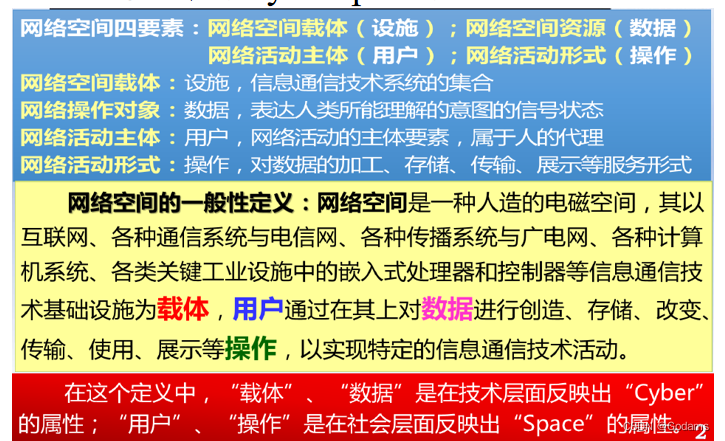
Review of network attack and defense
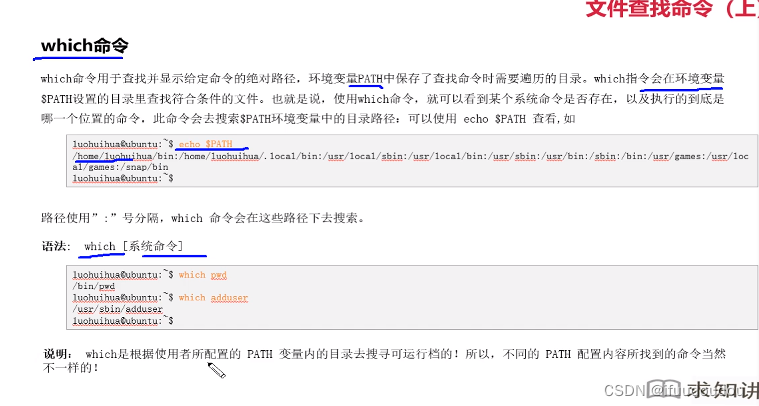
2022.07.05

PV static creation and dynamic creation
![[Verilog advanced challenge of Niuke network question brushing series] ~ multi bit MUX synchronizer](/img/7d/ed9a5c536b4cc1913fb69640afb98d.png)
[Verilog advanced challenge of Niuke network question brushing series] ~ multi bit MUX synchronizer

杰理之关于 TWS 声道配置【篇】
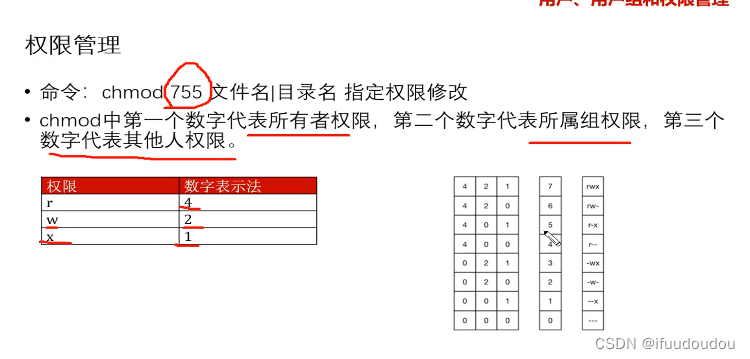
2022.07.04
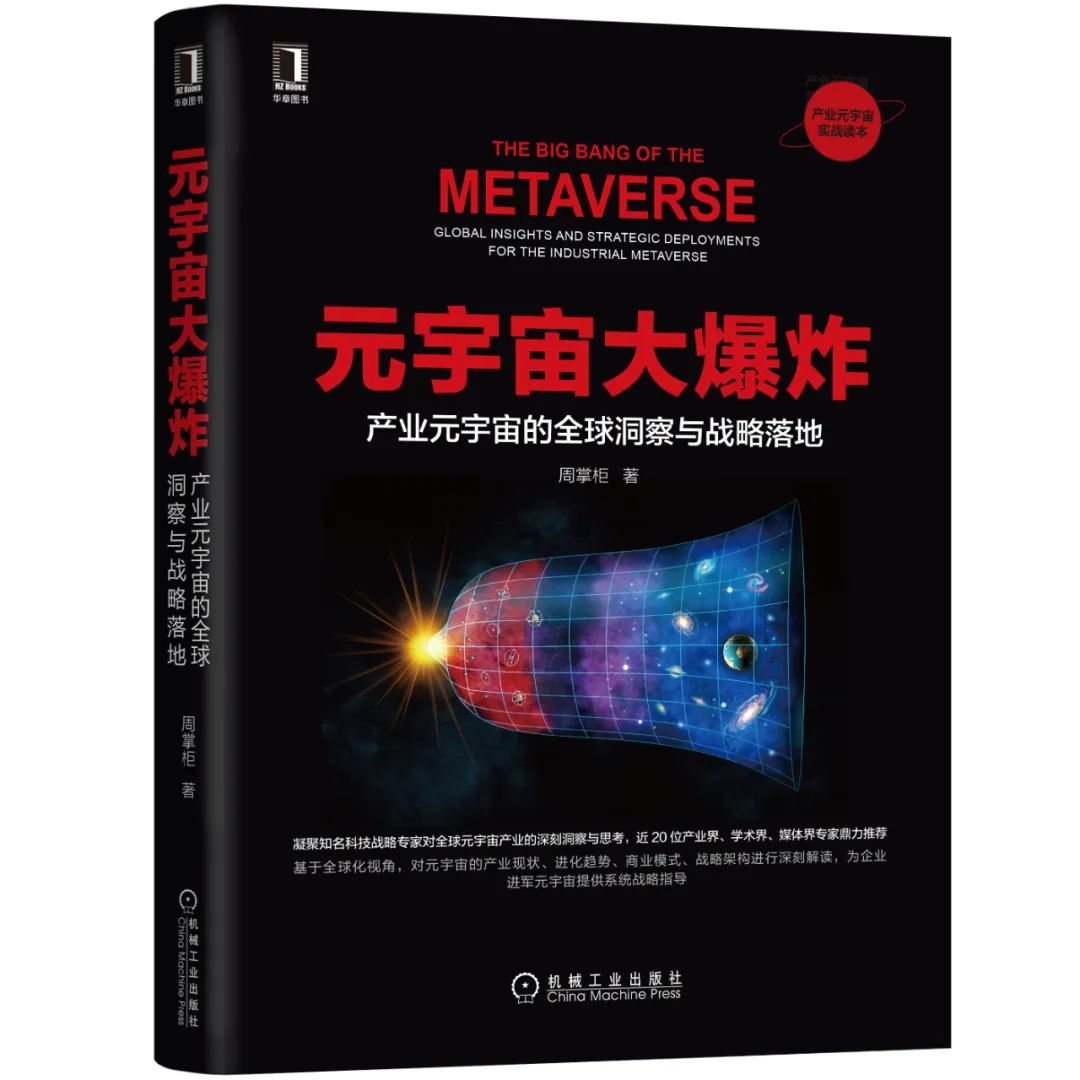
2022上半年朋友圈都在传的10本书,找到了
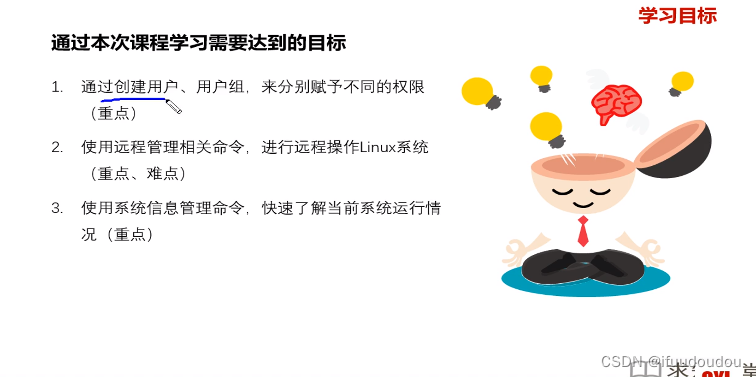
2022.07.02
随机推荐
【RT-Thread env 工具安装】
Former richest man, addicted to farming
转置卷积理论解释(输入输出大小分析)
Numpy——2.数组的形状
多个kubernetes集群如何实现共享同一个存储
PV静态创建和动态创建
反爬虫的重点:识别爬虫
[Verilog advanced challenge of Niuke network question brushing series] ~ multi bit MUX synchronizer
How to open an account for stock speculation? Excuse me, is it safe to open a stock account by mobile phone?
AI来搞财富分配比人更公平?来自DeepMind的多人博弈游戏研究
How to implement safety practice in software development stage
AI写首诗
杰理之开机自动配对【篇】
MySQL、sqlserver oracle数据库连接方式
【牛客网刷题系列 之 Verilog进阶挑战】~ 多bit MUX同步器
Pasqal首席技术官:模拟量子计算率先为工业带来量子优势
从39个kaggle竞赛中总结出来的图像分割的Tips和Tricks
Kirin Xin'an joins Ningxia commercial cipher Association
What does "true" mean
Business experience in virtual digital human